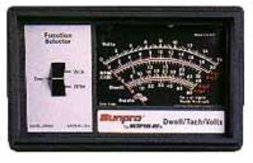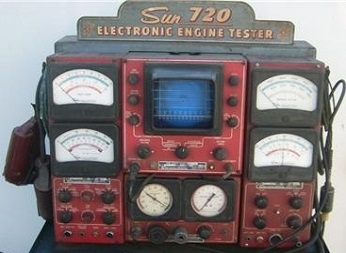
The basic cylinder balance test can be a great way to pinpoint a cylinder that’s under performing. When an engine has a rough running condition this is an indication a cylinder is not working as well as the other cylinders in the engine.
The correct name for the test is a cylinder power balance test and it is used to see if all of the engine cylinders are producing the same amount of power.
This should not be confused with an injector balance test that only checks the fuel side of the equation. Testing the injectors would be a logical second step if the power is not even from this test.
In a perfect world and on a properly running engine all cylinders will produce the same amount of energy. This can be confirmed and tested one at a time.
To check the engine’s power balance the spark plugs can be shorted out or disconnected one at a time so the cylinder will not fire. Then the change in engine speed is documented and compared.
I prefer to use an automotive meter with a RPM inductive pick up as opposed to a scan tool. If all of the cylinders are producing the same amount of power the engine RPMs will drop exactly the same amount on each cylinder that is canceled.
The cause of unequal power balance can mean a problem in the cylinders themselves, as well as in the piston rings, valve train, head gasket, fuel system, or even the ignition system.
Power Balance Test Basics

Back in the 80’s we would roll up the old Sun Scope and pull the wave pattern up on the pint sized CRT monitor.
This test can still be performed quickly and easily using an engine analyzer like the OTC 3980 that monitors RPM with an inductive pick up.
Although the sun scope had a convenient canceling button to automatically or manually control the firing of the individual spark plugs there are several way’s to turn off the spark one at a time. Many late model vehicles have a cylinder cancel feature that’s accessed through the engine control module.
This test is either a part of a routine self-diagnostic operating mode or must be activated by the mechanic through a scan tool.
They call them enhanced modes on the scan tool, because it allows manual control by turning on and off different functions.Car makers use these OBDII functions to calculate and set engine misfire codes. This beats pulling the wire off the plug with the engine running and getting hit with a high energy jolt.Some mechanics short the wire out by piercing it at the coil or distributor using a test light connected to a strong ground. If you do this, the wire should be replaced or the hole filled with silicone.
On some computer-controlled engines certain components must be disconnected before attempting a power balance test. Always check your car repair manual for appropriate procedures. They will supply step by step instructions for your specific vehicle.
Be careful not to run the engine with a shorted cylinder for more than 10 or 15 seconds. The liquid fuel in the exhaust can damage the catalytic converter and create an unsafe situation.
It is also a good idea to run the engine on all cylinders for a minute or two before proceeding to the next cylinder cancellation. The automotive scanner can read RPM from the data stream, but the results are not as fast as the digital inductive pick up on a meter. You need fast and accurate rpm readings when performing the balance test.
Analyzing Power Balance Test Data
You connect the engine analyzer leads as per the instructions, then turn the engine on and allow it to reach normal operating temperature. It is recommended to set the engine speed at a thousand RPMs by shimming the throttle.
This will give you a good base line for testing. It’s also recommended that you connect a vacuum tester to an intake manifold port. As each cylinder is shorted note and record the RPM drop and also the change in vacuum. As each cylinder is shorted, a noticeable drop in engine speed should be detected.
Little or no decrease in RPMs indicates a weak cylinder. The ATD automotive tester above has an inductive Rpm pick up so you can read engine speed accurately.
If all of the readings are fairly close to each other, the engine cylinders are in good condition. If the readings from one or more cylinders differ from the rest then a problem should be looked into on that cylinder.
As mentioned above many things can cause a week cylinder and it may take some time to pinpoint the engines exact problem. One possibility is a leaking head-gasket. They make a testing fluid that can confirm this problem by testing for the presence of hydrocarbons.
Give this engine testing page a bookmark or share with friends.
I have a lot more information to share on not only engine testing procedures but also theory and operation as well. This next link takes you from cylinder balance test to automotive engines info.
The homepage will explain what else is found on this car repair website. You can also receive some more YouFixCars.com auto repair advice.

